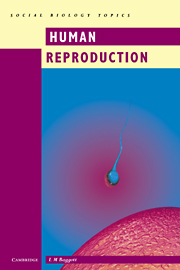Book contents
- Frontmatter
- Contents
- 1 Human reproductive strategies
- 2 Gamete production
- 3 Fertilisation
- 4 Implantation and pregnancy
- 5 Birth and lactation
- 6 Contraception
- 7 Human infertility: background and causes
- 8 Human subfertility: options and treatment
- 9 Ethical and moral considerations of fertility and infertility
- Index
1 - Human reproductive strategies
Published online by Cambridge University Press: 05 June 2012
- Frontmatter
- Contents
- 1 Human reproductive strategies
- 2 Gamete production
- 3 Fertilisation
- 4 Implantation and pregnancy
- 5 Birth and lactation
- 6 Contraception
- 7 Human infertility: background and causes
- 8 Human subfertility: options and treatment
- 9 Ethical and moral considerations of fertility and infertility
- Index
Summary
It has been said that the final aim of all human love relationships between men and women is more important than all other ends in life, because what it determines is nothing less than the composition of the next generation. It is perhaps no coincidence, then, that reproduction – involving, as it does, sexual intercourse – has come to occupy such an important part of our lives. It is the driving force of evolution, and hence generates the great variety of living organisms which inhabit, and have inhabited, the Earth, including, of course, ourselves. However, notwithstanding the power of evolution, or perhaps because of the force of it, sex has come to mean much more to us than reproduction.
Normal sexual intercourse has been defined as anything erotic which gives pleasure to both partners, who are consenting adults, and does not hurt anyone. This clearly holds good for a wide variety of sexual functions within loving relationships. In this context, the word love should be taken to mean the desire for the good of the other person; wishing for gain, or to exercise power over another person does not occur in a loving relationship.
Clearly, there are not only emotional but also physical risks associated with having a sexual relationship. Unwanted pregnancies and sexually transmitted diseases can all too easily follow from unprotected sexual intercourse (see chapter 6 for more information about contraception).
- Type
- Chapter
- Information
- Human Reproduction , pp. 5 - 9Publisher: Cambridge University PressPrint publication year: 1997



